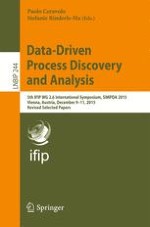2017 | Book
Data-Driven Process Discovery and Analysis
5th IFIP WG 2.6 International Symposium, SIMPDA 2015, Vienna, Austria, December 9-11, 2015, Revised Selected Papers
Editors: Paolo Ceravolo, Stefanie Rinderle-Ma
Publisher: Springer International Publishing
Book Series : Lecture Notes in Business Information Processing
